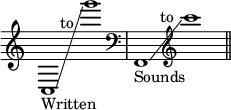BASSET-HORN
Corno di Bassetto
Bassethorn
Cor de basset
The name basset-horn, like english horn, is misleading. The instrument was invented in the year 1770 by a German clarinet maker by the name of Horn. He called his invention basset—"Horn," which means "Little bass (clarinet made by) Horn." the Italians and french, unaware of this circumstance, translated the name "horn" literally, hence the designations "corno di bassetto" and "cor de basset," both of which are misnomers.
The basset-horn is a tenor clarinet in F provided with additional keys which extend its downward range to C instead of E, as in ordinary clarinets. The bell joint is made of metal and is more flaring than that of other clarinets. Owing to the wide bore of the instrument, the tone of the basset-horn is particularly rich and agreeably reedy.
Among the great composers, Mozart stands foremost in his appreciation and use of this beautiful instrument, having employed it in several of his operas, in chamber music, and in his Requiem. Since his time it has gradually fallen into disuse, for what reason it is difficult to conjecture, but on account of its fine tone and facility of execution it is again attracting the attention of serious orchestral composers. It is written in the treble clef as a transposing instrument in F, its tones sounding a fifth lower than its notation.

